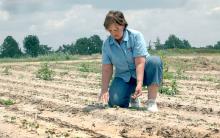Information Possibly Outdated
The information presented on this page was originally released on May 19, 2006. It may not be outdated, but please search our site for more current information. If you plan to quote or reference this information in a publication, please check with the Extension specialist or author before proceeding.
Slow, delayed cotton begins playing 'catch-up'
MISSISSIPPI STATE -- Hot temperatures in April excited cotton growers with the prospect of an early crop, but the return of cool, wet conditions delayed growth and later plantings.
Peggy Thaxton, associate professor at the Delta Research and Extension Center in Stoneville, said her research plots were not planted until mid-May.
“Most of these last fields should catch up with the earlier planted cotton because of the slow growth those fields experienced in the cool weather,” Thaxton said. “Later-planted seedlings should not experience the disease that the early, slow-growing cotton faced.”
Thaxton said growers want cotton to grow quickly to avoid seedling disease and insect damage early on. They also want it to mature as early as possible to avoid late-season insects, hurricanes and other weather damage. Cold weather near harvest can slow maturity even more and put cotton more at risk of yield and quality damage.
“As the hotter days arrive to stay, the crop should quickly rebound, grow off fast and have equal yield potential with the earlier planted cotton,” she said. “Growers now will have to turn their attention to watching for insect pests like thrips and plant bugs.”
Angus Catchot, Extension cotton entomologist, said weather conditions have kept the crop at a susceptible stage for thrips for a longer period of time.
“The cotton has been so beat up from wind and weather that it is not growing off very fast,” Catchot said. “Once the plants get to the four-leaf stage, we can quit worrying about thrips. Some growers are having to make foliar applications where seed treatments have worn off. Warmer temperatures should help the crop start growing better.”
Mississippi's Boll Weevil Eradication Program has eliminated cotton's worst late-season pest. About half of the state -- roughly the eastern counties from Tennessee to the Coast and across to the south Delta -- have succeeded in eliminating boll weevils in those fields.
Jeannine Smith, executive director of the Mississippi Boll Weevil Management Corp., said there was almost 47 percent fewer boll weevils captured in 2005 compared to the previous year. For eradication management purposes, the state is divided into four regions: Region 4 is a line two counties deep along the Alabama line from north to south, Region 3 is the central hills, Region 2 is the south Delta, and Region 1 is the north Delta. Region 1 is subdivided with 1A being the hill/ bluff line and Tunica County and 1B being the counties along the river.
“Region 4 is in a post-eradication program and most of southern part of Region 3 is as well. Last year, there was no evidence of boll weevil reproduction in regions 1B and 2. It is likely that eradication has been accomplished in those areas along with significant portions of regions 1A,” Smith said.




